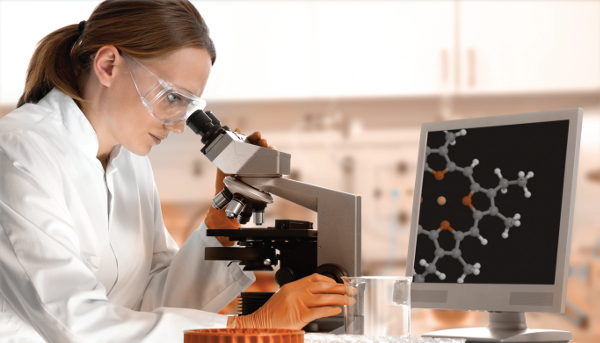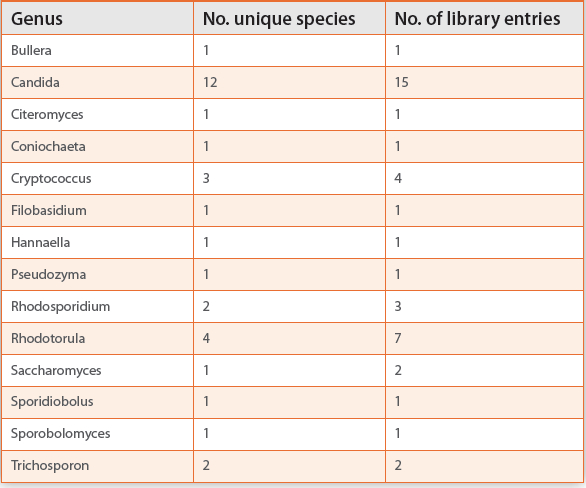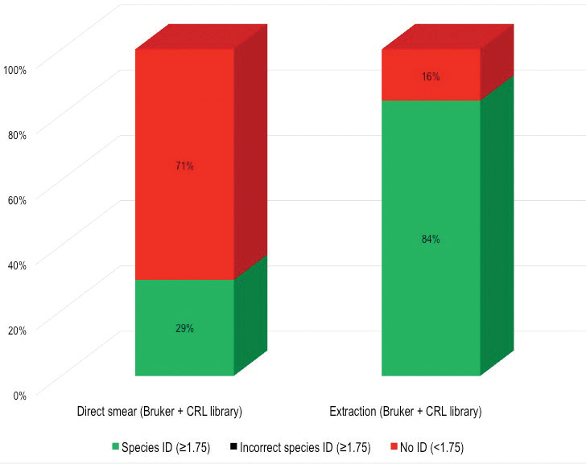Introduction
Microbial contaminants in pharmaceutical, food, and cosmetic products can be potentially detrimental to human health. Release of contaminated products can cause tremendous financial losses to a company as a result of product recalls, fines, and complex investigations to establish root cause. Not to mention, the significant damage to a company’s reputation due to attrition of consumer trust. To safeguard public health, regulatory agencies such as the Food and Drug Administration (FDA), require pharmaceutical, food, and cosmetic industries to manufacture and release products that are not contaminated.1–3 As a result, companies implement an Environmental Monitoring (EM) program to help ensure products from their manufacturing facilities are free of microbial contamination. The purpose of an EM program is to demonstrate a state of control by detecting organisms as a function of location and time which are transient or resident in their facilities before these microbes can potentially contaminate a product.4–5
An ideal EM program should have the ability to detect and identify all categories of microbes - bacteria, yeasts and molds. The focus of this article will be on identifying yeasts commonly found during environmental monitoring. Yeasts belong to the kingdom of fungi and are placed in the phyla of Ascomycota and Basidiomycota. They are typically single-celled organisms that reproduce by fission or budding. Yeasts have been central to one of the earliest biological process developed for human use due to their ability to ferment carbohydrates into alcohol and carbon dioxide. Their widespread application in products related to beverages, food and pharmaceuticals - to name a few - have raised their commercial relevance. Alternatively, yeasts can be opportunistic pathogens causing mild to life-threatening infections6 from varied sources, such as a human commensal (e.g. Candida albicans in the human gut) or the environment (e.g. Cryptococcus neoformans in soil or bird droppings). Therefore, both in beneficial and harmful ways, yeasts are important organisms for humans.

Whether it is for diagnosing a patient with a potential yeast infection, or for an Environmental Monitoring (EM) program in a manufacturing facility, accurate identification (ID) is key to guiding appropriate therapy or remediation activities, respectively. For an EM program, this information can be used to track and trend the facility’s microflora, and establish microbial alert and action limits.4 There are several technologies available for yeast identification; however, the use of ITS2 gene sequences has emerged as an important approach over the past decade.7–9 In recent years, profiling cellular proteins using matrixassisted laser desorption ionization–time of flight mass spectrometry (MALDI-TOF MS) as the basis for identification has shown promise.10 The process of using MALDI-TOF MS for microbial ID involves ionizing abundant cellular proteins, predominantly ribosomal,11 with a lowmass organic compound (α-Cyano-4-hydroxycinnamic acid) and a UV laser as the energy source. Gas phase ions in the molecular mass range of 2K to 20K Daltons are separated in the time-of-flight analyzer by applying an electrical field. The detected ions are transformed into a spectrum that displays the relationship between various masses and their abundance. In most cases, this spectral protein profile is unique to a species, which forms the rationale for identification. Both commercially available MALDI-TOF MS systems (MALDI Biotyper from Bruker Daltonics and VITEK® MS from bioMérieux) have developed libraries of reference spectra representing various species. The spectra from an unknown organism is searched against the library to calculate a numerical score value that signifies the “closeness” of the unknown spectra to the reference library entry. The magnitude of the score value determines the confidence for identification - greater value indicating a superior match. Although identification of yeasts commonly found in clinical settings by this technology is mainstream,12–15 its performance is less understood for yeast isolates commonly found during environmental monitoring in manufacturing processes. Based on our experience at Charles River Laboratories (CRL) of identifying yeasts by DNA sequencing for our customers with EM programs, and a review of the literature in clinical microbiology, it is apparent that many yeasts pertinent to manufacturing processes are likely to belong to different species, and possess intraspecific diversity that is greater than that found in clinical settings. The goal of this study was to optimize and evaluate performance of MALDI-TOF MS for yeasts commonly found during environmental monitoring.
 Figure 1. Study cohort by genus (n=152)
Figure 1. Study cohort by genus (n=152)Materials and Methods
Study isolates - Yeast isolates (152) representing 65 unique species and 19 unique genera were selected based on their frequency of occurrence of testing at CRL. Reference species identification of these isolates was performed by sequencing the ITS2 portion of the ribosomal RNA gene region and comparing the sequences to the validated CRL reference library. A phylogenetic analysis of the sequences was performed to determine the reference ID of the test isolates.
MALDI-TOF MS - Isolates were cultivated as pure cultures at 32°C on Sabouraud Dextrose Agar and tested by MALDI-TOF MS at 24 hours of growth. The direct smear method with 0.4 μL 100% formic acid overlay was tested for a subset of isolates (n=51). All samples were processed by the formic acid/acetonitrile extraction method recommended by Bruker Daltonics. Mass spectra were acquired for two spots per isolate. Data were collected between 2,000 and 20,000 m/z in linear positive ionization mode using the Real Time Classification Biotyper 4.0 software with library version 5989 (Bruker Daltonics) and autoflex™ instrument (Bruker Daltonics). Each spectrum was a sum of 1000 shots collected in increments of 250.
MALDI-TOF MS CRL library development - Isolates that failed to identify and additional isolates of the same species were used to generate MALDI-TOF MS library entries as per the cGMP-compliant procedures at CRL. A supplemental MALDI library database containing 41 entries was developed. These 41 entries represented 32 unique species spanning 14 unique genera when compared to the species entries in the Bruker database.
Data analysis - The spot (out of two) resulting in the higher score value was used for analysis. Concordance was calculated after applying scoring thresholds (2.0-3.0 for high confidence identification and 1.7- 1.999 for low confidence identification) as per Bruker’s recommendation and using CRL’s internally validated thresholds for bacterial identification (≥1.75 for specieslevel and <1.75 for no identification). In addition, concordance and performance were calculated with and without CRL’s supplemental MALDI library entries in the reference database.
Results
CRL yeast library development - The Bruker Daltonics MALDI-TOF MS library (version 5989) had 690 fungi, of which approximately 95% are yeasts. During this study, CRL added 41 new MALDI-TOF MS library entries (Table 1).
Table 1. Number of species by genus that were added to the CRL library to improve coverage (n=41).

Performance of MALDI-TOF MS - Concordance was calculated by applying score thresholds and comparing IDs by MALDI-TOF MS with the IDs obtained by sequencing the ITS2 portion of the ribosomal RNA gene region. With Bruker’s MALDI-TOF MS library and score thresholds, identification rates were 59% (90/152) to species (score ≥2.0), 11% (16/152) were low confidence scores (≥1.7 to 2.0), and 29% (44/152) were not a reliable ID (<1.7) (Figure 3). Several published studies have shown the relationship between optimizing MALDI-TOF MS score thresholds to increase identification rates without significantly compromising accuracy.16–18 Identification rates improved to 82% (124/152) to species (score ≥1.75), and 17% (26/152) were not a reliable ID (<1.75), when CRL’s supplemental MALDI-TOF MS library and score thresholds were applied (Figure 3). There was a 1% (2 of 152) species-level misidentification rate using both Bruker’s and CRL’s score thresholds. It is important to note that the number of incorrect IDs did not increase when the species-level score threshold was lowered to ≥1.75, indicating that the incorrect IDs occurred at scores >2.0. Of the two discrepant IDs, the first was Rhodotorula slooffiae identified as Rhodotorula minuta, and the second was Cryptococcus albidus identified as Cryptococcus liquefaciens, by MALDI-TOF MS. In both cases, the species in question are closely related and may either require new library entries for accurate species resolution, or may end up as “species group” level IDs. Overall, these results show that MALDI-TOF MS is an effective platform for identification of yeast commonly found during environmental monitoring, but supplementing the library with the diversity of isolates relevant to manufacturing processes (Table 2) and optimizing score thresholds is critical to improved performance (Figure 3).
 Figure 3. Performance of MALDI-TOF MS for yeast identification (n=152).
Figure 3. Performance of MALDI-TOF MS for yeast identification (n=152).Conclusions
Several clinical validation studies published since 2009 have shown identification rates using MALDI-TOF that range from 80% to 100% with the formic acid/acetonitrile extraction method.12–15 Based on the results of this study, the direct smear method was not as efficient as the extraction method for sample preparation before MALDI-TOF MS spectra acquisition. However, all species IDs that were generated with the direct smear method were concordant with the IDs obtained by extraction method and the ITS2 sequence based IDs (Figure 2). With Bruker’s MALDI-TOF MS library and score thresholds, identification rates were 59% (90/152) to species (score ≥2.0), 11% (16/152) were low confidence scores (≥1.7 to 2.0), and 29% (44/152) were not a reliable ID (<1.7) (Figure 3). As expected, identification rates improved to 82% (124/152) to species (score ≥1.75), and 17% (26/152) were not a reliable ID (<1.75), when CRL’s supplemental MALDI-TOF MS library and score thresholds were applied (Figure 3) with equivalent accuracy of the results. These data with isolates primarily from manufacturing environments, and numerous studies with isolates from clinical settings6, 12–15 show that MALDI-TOF MS can provide yeast identifications with high accuracy. This system becomes an even more favorable option for routine yeast identifications when its other advantages, like low reagent cost and rapid sample processing time, are considered. Nevertheless, it has been noted in several studies with clinical isolates that the performance of a MALDI-TOF MS system depends on the breadth of library coverage.6, 15, 19 Similarly, our study highlights the necessity of expanding the MALDITOF MS library with new entries to capture strain and species diversity that is present in environmental samples so that the operational performance can be improved.

Figure 2. Performance of MALDI-TOF MS by direct smear and extraction methods (n=51).
References
- Food and Drug Administration. Guidance for Industry. Sterile Drug Products Produced by Aseptic Processing – Current Good Manufacturing Practice (2004).
- Food and Drug Administration. Regulation 21 CFR Part 211 – Current Good Manufacturing Practice for Finished Pharmaceuticals (2011).
- Food and Drug Administration. Regulation 21 CFR Part 111 – Current Good Manufacturing Practice in Manufacturing, Packaging, Labeling, or Holding Operations for Dietary Supplements (2011).
- Sutton S. The Environmental Monitoring Program in a GMP Environment. Journal of GXP Compliance. 2010; 14(3):22–30.
- Polarine J and Sartin EK. Prevention of Microbial Contamination. Pharmaceutical Technology. 2011;35(6).
- Buchan BW and Ledeboer NA. Advances in Identification of Clinical Yeast Isolates by Use of Matrix-Assisted Laser Desorption Ionization–Time of Flight Mass Spectrometry. Journal of Clinical Microbiology. 2013;51(5):1359–1366.
- Leaw SN, Chang HC, Sun HF, Barton R, Bouchara J-P and Chang TC. Identification of Medically Important Yeast Species by Sequence Analysis of the Internal Transcribed Spacer Regions. Journal of Clinical Microbiology. 2006;44(3):693–699.
- Khot PD, Ko DL and Fredricks DN. Sequencing and Analysis of Fungal rRNA Operons for Development of Broad-Range Fungal PCR Assays. Applied and Environmental Microbiology. 2009;75(6):1559–65.
- Slechta ES, Hohmann SL, Simmon K and Hanson KE. Internal transcribed spacer region sequence analysis using SmartGene IDNS software for the identification of unusual clinical yeast isolates. Medical Mycology. 2012; 50(5).
- Clark AE, Kaleta EJ, Arora A and Wolk DM. Matrix- Assisted laser desorption ionization-time of flight mass spectrometry: A fundamental shift in the routine practice of clinical microbiology. Clinical Microbiology Reviews. 2013;26(3):547–603.
- Ryzhov V and Fenselau C. Characterization of the Protein Subset Desorbed by MALDI from Whole Bacterial Cells. Analytical Chemistry. 2001;73(4):746–750.
- Marklein G, Josten M, Klanke U, et al. Matrix-Assisted Laser Desorption Ionization-Time of Flight Mass Spectrometry for Fast and Reliable Identification of Clinical Yeast Isolates. Journal of Clinical Microbiology. 2009;47(9):2912–2917.
- Dhiman N, Hall L, Wohlfiel SL, Buckwalter SP and Wengenack NL. Performance and Cost Analysis of Matrix- Assisted Laser Desorption Ionization–Time of Flight Mass Spectrometry for Routine Identification of Yeast. Journal of Clinical Microbiology. 2011;49(4):1614–1616.
- Mancini N, Carolis ED, Infurnari L, et al. Comparative Evaluation of the Bruker Biotyper and Vitek MS Matrix Assisted Laser Desorption Ionization–Time Of Flight (MALDI-TOF) Mass Spectrometry Systems for Identification of Yeasts of Medical Importance. Journal of Clinical Microbiology. 2013;51(7):2453–2457.
- Pinto A, Halliday C, Zahra M, et al. Matrix-Assisted Laser Desorption Ionization-Time of Flight Mass Spectrometry Identification of Yeasts Is Contingent on Robust Reference Spectra. PLoS ONE. 2011; 6(10):e25712.
- Van Herendael BH, Bruynseels P, Bensaid M, et al. Validation of a modified algorithm for the identification of yeast isolates using matrix-assisted laser desorption/ ionization time-of-flight mass spectrometry (MALDITOF MS). European Journal of Clinical Microbiology & Infectious Diseases. 2012;31(5):841–848.
- Szabados F, Tix H, Anders A, Kaase M, Gatermann SG and Geis G. Evaluation of species-specific score cutoff values of routinely isolated clinically relevant bacteria using a direct smear preparation for matrix-assisted laser desorption/ionization time-of-flight mass spectrometry-based bacterial identification. European Journal of Clinical Microbiology & Infectious Diseases. 2012;31(6):1109–1119.
- Khot PD, Couturier MR, Wilson A, Croft A, Fisher MA. Optimization of Matrix-Assisted Laser Desorption Ionization–Time of Flight Mass Spectrometry Analysis for Bacterial Identification. Journal of Clinical Microbiology. 2012;50(12):3845–3852.
- Carolis ED, Vella A, Vaccaro L, et al. Development and Validation of an In-House Database for Matrix- Assisted Laser Desorption Ionization–Time of Flight Mass Spectrometry-Based Yeast Identification Using a Fast Protein Extraction Procedure. Journal of Clinical Microbiology. 2014;52(5):1453–1458.